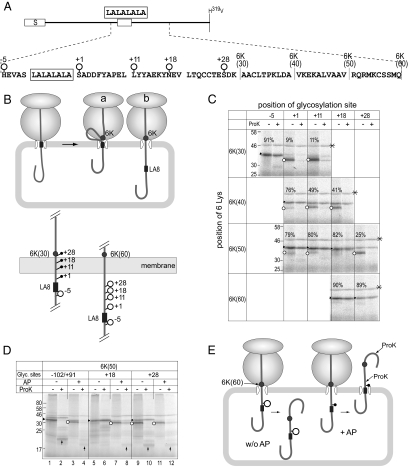Figure 4.
LA8-segment is exposed to the lumen. (A) Glycosylation site scanning model protein to probe accessibility for OSTase in the lumen. Glycosylation site was created at one of the indicated positions (○) and 6K-cluster was inserted at one of the indicated sites. (B) Possible topologies of the LA8-segment during stop-translocation; the LA8-segment is statically retained at the membrane translocon (a) or is exposed to the lumen (b) before the 6K-cluster exerts its function. To address these possibilities, potential glycosylation site was scanned. Their glycosylation status of the 6K(30) and 6K(60) models assessed in C are schematically shown. Glycosylated potential site (○) and nonglycosylated potential site (shaded dots) are indicated. (C) The full-length model proteins were expressed in the presence of RM. Aliquots were treated with ProK. Monoglycosylated (▶) and nonglycosylated forms (○) are indicated. Percent monoglycosylation is indicated in the panel. Asterisks denote nonspecific product. (D) Effect of glycosylation inhibition on the translocation. The model proteins included 6K-cluster at position (+50) and potential glycosylation sites at indicated position. Translation of each full-length model protein was performed in the presence or absence of AP. Monoglycosylated forms (▶), nonglycosylated forms (○), and ProK-resistant fragments (↑) are indicated. In these experiments, a high concentration of ProK (400 μg/ml) was used. The product monoglycosylated at position (−102) was ProK-sensitive, whereas that monoglycosylated at position (+18) was completely ProK-resistant. The latter model became ProK-sensitive when the glycosylation was suppressed with AP. (E) The sugar chain at position (+18) induced full translocation. Inhibition of the glycosylation by AP caused membrane spanning of the LA8-segment. Glycosylated potential site (○) and nonglycosylated potential site (shaded dots) are indicated. Sugar chain keeps the LA8-segment in the lumen and prevents cooperation of the LA8-segment and the 6K-cluster to cause forward movement.

